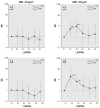Low dose of some persistent organic pollutants predicts type 2 diabetes: a nested case-control study
- PMID: 20444671
- PMCID: PMC2944083
- DOI: 10.1289/ehp.0901480
Low dose of some persistent organic pollutants predicts type 2 diabetes: a nested case-control study
Abstract
Background: Low doses of some persistent organic pollutants (POPs) associate cross-sectionally with type 2 diabetes, whereas associations with high POP exposures are inconsistent.
Objectives: We investigated whether several POPs prospectively predict type 2 diabetes within the Coronary Artery Risk Development in Young Adults (CARDIA) cohort.
Methods: Participants in this nested case-control study were diabetes free in 1987-1988. By 2005-2006, the 90 controls remained free of diabetes, whereas the 90 cases developed diabetes. Using serum collected in 1987-1988, we measured 8 organochlorine pesticides, 22 polychlorinated biphenyl congeners (PCBs), and 1 polybrominated biphenyl (PBB). We compared POP concentrations from CARDIA and the National Health and Nutrition Examination Survey (NHANES) in 2003-2004. We computed odds ratios (ORs) for incident diabetes using logistic regression analysis.
Results: Chlorinated POPs in CARDIA in 1987-1988 were much higher than corresponding NHANES 2003-2004 concentrations. POPs showed nonlinear associations with diabetes risk. The highest risk was observed in the second quartiles of trans-nonachlor, oxychlordane, mirex, highly chlorinated PCBs, and PBB153-a finding that suggests low-dose effects. We concentrated risk by summing these POPs and isolated very low concentrations of multiple POPs in the lowest sextile of the sum. The adjusted OR in the second sextile vs. the lowest sextile was 5.3 overall and 20.1 for body mass index > or = 30 kg/m2.
Conclusions: Several POPs at low doses similar to current exposure levels may increase diabetes risk, possibly through endocrine disruption. Certain POPs may a play a role in the current epidemic of diabetes, which has been attributed to obesity.
Figures


References
-
- Centers for Disease Control and Prevention (CDC) National Health and Nutrition Examination Survey: NHANES 2003–2004. 2010. [[accessed 20 July 2010]]. Available: http://www.cdc.gov/nchs/nhanes/nhanes2003-2004/nhanes03_04.htm.
-
- Daston GP, Cook JC, Kavlock RJ. Uncertainties for endocrine disrupters: our view on progress. Toxicol Sci. 2003;74(2):245–252. - PubMed
-
- Friedman GD, Cutter GR, Donahue RP, Hughes GH, Hulley SB, Jacobs DR, Jr, et al. CARDIA: study design, recruitment, and some characteristics of the examined subjects. J Clin Epidemiol. 1988;41(11):1105–1116. - PubMed
-
- Henriksen GL, Ketchum NS, Michalek JE, Swaby JA. Serum dioxin and diabetes mellitus in veterans of Operation Ranch Hand. Epidemiology. 1997;8(3):252–258. - PubMed
-
- Howard BV. Insulin resistance and lipid metabolism. Am J Cardiol. 1999;84(1A):28J–32J. - PubMed
Publication types
MeSH terms
Substances
Grants and funding
- N01 HC095095/HL/NHLBI NIH HHS/United States
- N01 HC048048/HL/NHLBI NIH HHS/United States
- R01 HL053560/HL/NHLBI NIH HHS/United States
- N01-HC-48047/HC/NHLBI NIH HHS/United States
- N01-HC-95095/HC/NHLBI NIH HHS/United States
- N01-HC-48050/HC/NHLBI NIH HHS/United States
- N01-HC-48049/HC/NHLBI NIH HHS/United States
- N01 HC048047/HL/NHLBI NIH HHS/United States
- N01 HC048050/HL/NHLBI NIH HHS/United States
- N01-HC-48048/HC/NHLBI NIH HHS/United States
- R01-HL-53560/HL/NHLBI NIH HHS/United States
- N01 HC048049/HL/NHLBI NIH HHS/United States
LinkOut - more resources
Full Text Sources
Medical

